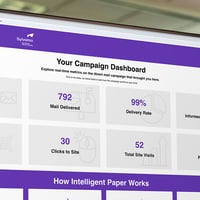4 Signs that You’re Using the Highest Quality Commercial Printing Paper
 Print matters. Whether it’s helping to increase the retention and recall of information, or creating a deeper connection with readers via a tactile experience, dynamic commercial print pieces like brochures, catalogs or direct mail postcards have the ability to engage and delight users in ways that digital content still can’t quite replicate.
Print matters. Whether it’s helping to increase the retention and recall of information, or creating a deeper connection with readers via a tactile experience, dynamic commercial print pieces like brochures, catalogs or direct mail postcards have the ability to engage and delight users in ways that digital content still can’t quite replicate.
A large part of creating the kind of print projects that capture and resonate with an audience is choosing the kind of high-caliber paper that can produce quality images and crisp, clear text. Not only will high-quality paper help you create pieces with more polish and flash, but it will also help you create commercial print pieces that are more effective and demonstrate a more meaningful ROI on your print communications spend.
However, the challenge is knowing what to look for when choosing the highest quality paper for commercial print projects. With this in mind, let’s look at four signs that let you know you’re using the highest quality commercial printing paper.
1. The paper has a high brightness value
Paper brightness is the measurement of the amount of reflectance of a specific wavelength of blue light. Using blue light to measure brightness stems from the fact that the human eye perceives a bluish tint as whiter than a neutral white. The brightness of a paper is important because it can impact how images or other design elements appear on the printed sheet.
Brightness is measured on a scale of 0 to 100. The higher the number, the greater the brightness value, and papers with a high brightness value are considered high-quality, premium papers because they help bright colors to appear more vibrant in print. For example, a paper with a 97 brightness is considered to be higher in quality than a 92 brightness paper.
Brightness should not be confused with whiteness, which measures the reflectance of all wavelengths of light and more closely aligns with how the human eye perceives paper. Whereas the brightness of paper is more cut and dry, whiteness is more variable based on the environment.
For more information on this, read more about the difference between paper brightness vs. whiteness.
2. The paper has a higher opacity
The opacity of your paper refers to the transparency of the sheet, or how much light shows through from one side of the paper to the other. A sheet with a high opacity allows very little light to pass through. In general, paper with a higher opacity is considered better quality because it can handle more ink coverage with less risk of show-through, and this makes it more versatile for a wider range of commercial printing applications, from booklets and instruction manuals to sell sheets and flyers.
For example, Accent® Opaque Text is a premium uncoated sheet with superior opacity — and 97 brightness — to help produce the highest quality print for any number of commercial uses.
3. The paper has a heavier basis weight
The basis weight of paper is how much a ream of paper (500 sheets) weighs based on the size of the sheet. Paper comes in several different grades — text, cover and bond, to name a few — and each grade has its own basic sheet size, which helps determine the basis weight. Papers with a heavier basis weight are thicker and sturdier, and this helps to minimize the risk of show-through from high ink coverage or double-sided printing.
Text is one of the more common grades used in commercial printing for applications like reports, financial documents, catalogs and sales and marketing collateral. The basis weight for the highest quality text sheets should range from 40 lb. to 100 lb. Cover, which is another frequently used paper grade in the commercial space, is used to print materials like invitations, greeting cards and menus, and the ideal basis weights for cover paper generally range from 65 lb. to 120 lb.
4. The paper has a smooth, level printing surface
The smoothness of a paper’s printing surface is determined by a number of factors, a couple of which include shape and orientation of the wood fibers in the paper, or the material composition of the paper. Paper with a smooth, level printing surface will result in a more even transfer of ink that helps produce crisp, vivid images with consistent color quality and stability. What’s more, paper with a smooth, level surface will promote proper ink hold out and fast drying characteristics.
Coated papers provide a smooth printing surface by sealing the fibers of the paper — however, coated papers can be a more costly choice for commercial printing, and they may not be compatible with the kind of press your commercial printer uses. Uncoated paper that has been calendered — which is the process of compressing the fibers to create a uniform, level surface — provides the same outstanding print and image quality as coated sheets, without the additional coating.
Plus, this process can also help you create visually engaging pieces that don’t break the bank, which leaves room in the budget for special finishes to make your project really stand out.
Accent Opaque Text and Cover are premium, uncoated papers that are designed for a variety of commercial printing applications. Available in a variety of basis weights with excellent opacity, our Text and Cover products help you take the next step in creating high-quality print. Request a sample to experience the quality of Accent paper for yourself.





